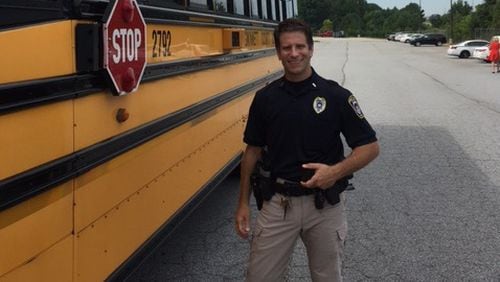Last week, we discussed the importance of the Safety Patrol program in Georgia schools. These belt-decorated student leaders help ensure their fellow students’ safety and serve as a reminder for drivers to behave cautiously around school zones. But commuter behavior extends well past the school grounds and is arguably even more impactful around school buses.
“The most important factor in regards to bus safety is just, first of all, being aware,” saidLt. Tony Lockard, a Student Resource Officer for Gwinnett County Schools Police Department.
Lockard is Gwinnett’s West Zone Commander, so his coverage area includes some of the worst traffic hot spots in the county: parts of Norcross, Duluth and Lilburn. And when traffic is bad, driver-patience is thin. Impatience and distractions compromise safety around school buses.
At a AAA “School’s Open - Drive Carefully” media event in Gwinnett, Lockard stands in front of one of the county’s 1,800 school buses. He says that the early dawn hours are especially dangerous. Students are running to their buses, maybe they’re late, and they’re possibly not looking before crossing the road. Gwinnett’s large population shares a critical responsibility in helping avoid tragedy. “[Gwinnett Schools] is the fourth-largest district in the nation,” Lockard shares. Let that set for a minute. Fourth-largest in the U.S.A.
Just seeing a bus in motion, he says, should trigger a driver’s awareness to slow down soon. “When the bus does slow and the yellow-amber lights come on, that’s indicating the bus is about to stop.” This does not mean motorists should speed up to beat the stopping bus. “It’s like a traffic signal, it’s a warning.”
While Gwinnett bus drivers do a great job checking to see that all vehicles have stopped before opening the doors, drivers have to obey the laws. In case there is any ambiguity as to when drivers have to stop for buses, Lockard is enthusiastic to share it.
“When you see the amber lights come on, you need to slow down and be prepared to stop. When the stop arm comes out, you have to stop and wait for that bus to start proceeding again.” He continues, “If you’re behind the bus, no matter what the roadway looks like, you have to stop.”
One exception does make the law tricky. “If you’re on the opposite side of the road, going the opposite direction, the only time you do not have to stop, is if it is a divided highway with, say, a concrete or grassy median.” And, Lockard says, “If there’s a center turn lane [but no median], you still have to stop.”
For those worrying how Gwinnett enforces this law, they have more than manpower. Approximately 300 of Gwinnett County Schools’ buses have stop light cameras, which are supposed to capture every vehicle that stops - but especially the ones that do not. Gwinnett piloted the program in the fall of 2014 and went active with it in 2015.
“The camera is buffering pretty much the entire time, which means it is recording the entire time. When the bus driver activates the red signal, then it stops the buffering and starts the recording. If anyone violates and goes past the bus when the stop lights are on and the the stop arm is out, it will record that violation.”
If the offending motorist has a question as to just how much they violated the law, Lockard says the camera knows. “It has a timer on it and it will indicate on that timer how long the yellow-amber lights have been flashing for and indicate how long the red lights will be on for.”
That should teach the violating driver a good lesson and the program should be an omen to others to give a wide berth to stopped buses and walking kids.
Laws, initiatives and technology aside, we as motorists all share the burden in preserving the lives of those most vulnerable in our society: children. Save a few weeks and snow days, school is back in until May. That’s nine months. Let’s slow down, stop, keep our eyes on the road and make this the safest school year ever for Georgia kids. Then, with less wrecks and investigations, there are less road blockages and traffic improves. Everyone wins.






